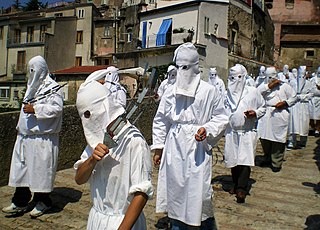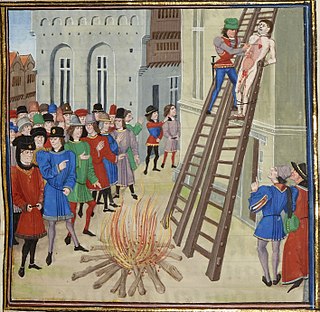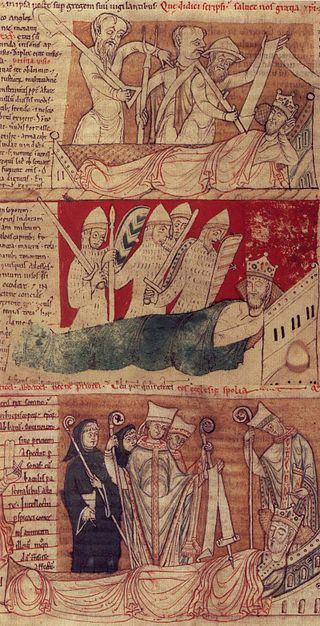Related Research Articles
Millennialism or chiliasm is a belief which is held by some religious denominations. According to this belief, a Messianic Age will be established on Earth prior to the Last Judgment and the future permanent state of "eternity".

Edward the Confessor was an Anglo-Saxon English king and saint. Usually considered the last king of the House of Wessex, he ruled from 1042 until his death in 1066.
Millenarianism or millenarism is the belief by a religious, social, or political group or movement in a coming fundamental transformation of society, after which "all things will be changed". Millenarianism exists in various cultures and religions worldwide, with various interpretations of what constitutes a transformation.
Peter Langtoft, also known as Peter of Langtoft, was an English historian and chronicler who took his name from the small village of Langtoft in the East Riding of Yorkshire.

Matthew Paris, also known as Matthew of Paris, was an English Benedictine monk, chronicler, artist in illuminated manuscripts, and cartographer who was based at St Albans Abbey in Hertfordshire. He authored a number of historical works, many of which he scribed and illuminated himself, typically in drawings partly coloured with watercolour washes, sometimes called "tinted drawings". Some were written in Latin, others in Anglo-Norman or French verse. He is sometimes confused with the nonexistent Matthew of Westminster.

Flagellants are practitioners of a form of mortification of the flesh by whipping their skin with various instruments of penance. Many Christian confraternities of penitents have flagellants, who beat themselves, both in the privacy of their dwellings and in public processions, to repent of sins and share in the Passion of Jesus.
Abiezer Coppe was one of the English Ranters and a writer of prophetic religious pamphlets.

Norman Rufus Colin Cohn FBA was a British academic, historian and writer who spent 14 years as a professorial fellow and as Astor-Wolfson Professor at the University of Sussex.
Robert Fabyan was a London draper, Sheriff and Alderman, and author of Fabyan's Chronicle.

Froissart's Chronicles are a prose history of the Hundred Years' War written in the 14th century by Jean Froissart. The Chronicles open with the events leading up to the deposition of Edward II in 1327, and cover the period up to 1400, recounting events in western Europe, mainly in England, France, Scotland, the Low Countries and the Iberian Peninsula, although at times also mentioning other countries and regions such as Italy, Germany, Ireland, the Balkans, Cyprus, Turkey and North Africa.
The Scalacronica (1066–1363) is a chronicle written in Anglo-Norman French by Sir Thomas Grey of Heaton near Norham in Northumberland. It was started whilst he was imprisoned by the Scots in Edinburgh Castle, after being captured in an ambush in October 1355, and completed in England after his release. The chronicle documents the history of Britain until 1363, and is one of the few early chronicles written by a layman.
The Pursuit of the Millennium: Revolutionary Millenarians and Mystical Anarchists of the Middle Ages is Norman Cohn's study of millenarian cult movements.

John of Worcester was an English monk and chronicler who worked at Worcester Priory. He is now usually held to be the author of the Chronicon ex Chronicis.
Éon de l'Étoile, from the Latin Eudo de Stella, was a Breton religious leader and "messiah". He opposed the Roman Catholic Church to the point of pillaging abbeys and monasteries and accumulating a large treasure during a period of eight years (1140–48). He was considered little more than an "illiterate idiot" by the Church authorities.
The turlupins were a religious sect in medieval France, loosely related to the Beguines and Beghards and the Brethren of the Free Spirit. The name turlupin is a derisive epithet; they appear to have called themselves the "society of the poor" or "fellowship of poverty". Mention of them survives only in writings of their opponents, who condemned them as heretics. From Avignon, Pope Gregory XI excommunicated them as heretics. Therefore, very little is known about them, but they apparently wore few clothes as an expression of the vow of poverty, which led to accusations of nudism and promiscuity. Some historians think their importance may have been exaggerated to add "local colour" to academic theological disputes.

Europe's Inner Demons: An Enquiry Inspired by the Great Witch-Hunt is a historical study of the beliefs regarding European witchcraft in Late Medieval and Early Modern Europe, with particular reference to the development of the witches' sabbat and its influence on the witch trials in the Early Modern period. It was written by the English historian Norman Cohn, then of the University of Sussex, and first published by Sussex University Press in association with Heinemann Educational Books in 1975. It was released as a part of a series of academic books entitled 'Studies in the Dynamics of Persecution and Extermination' that were funded by the Columbus Centre and edited by Cohn himself.
Peter Kániš was a priest and theologian during the Bohemian reformation, being the chief spokesman for the Taborites. Along with other Taborites, he was burned at the stake for heresy by Jan Žižka, who wanted to control the most radical parts of the reformation. Kániš advocated the postponement of baptism until the age of thirty over infant baptism. He took a memorialist view of the Eucharist. Bishop Nicholas Biskupec wrote a treatise against him defending the real presence of Christ in the Eucharist. A few of those led by Kániš and Martin Húska would later form the Adamite sect.
Konrad Schmid was the leader of a group of flagellants and millenarians in Thuringia.
The Tafurs were a group of Christian participants of the First Crusade. Zealots following strict oaths of poverty, they are said to have committed acts of cannibalism during the siege of Antioch or the siege of Ma'arra.
References
- ↑ Ormrod, W. M. "Avesbury, Robert". Oxford Dictionary of National Biography (online ed.). Oxford University Press. doi:10.1093/ref:odnb/23738.(Subscription or UK public library membership required.)
- ↑ Cohn, Norman, The Pursuit of the Millennium: Revolutionary Millenarians and Mystical anarchists of the Middle Ages (1970)
Cohn, Norman, The Pursuit of the Millennium: Revolutionary Millenarians and Mystical anarchists of the Middle Ages (1970)
- Attribution
![]() This article incorporates text from a publication now in the public domain : Kingsford, Charles Lethbridge (1896). "Robert of Avesbury". In Lee, Sidney (ed.). Dictionary of National Biography . Vol. 48. London: Smith, Elder & Co.
This article incorporates text from a publication now in the public domain : Kingsford, Charles Lethbridge (1896). "Robert of Avesbury". In Lee, Sidney (ed.). Dictionary of National Biography . Vol. 48. London: Smith, Elder & Co.